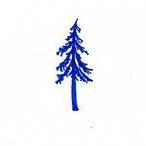
Ivy is a plant that attracts strong opinions, especially when arborists are asked to consider its impact on trees and their ecology. Andrew Cowan considers some of the common arguments for and against ivy, while also looking at the influence of climate change on the natural balance of arboreal ecosystems.
When I first tackled this issue it was with the objective of expressing some form of balance to the frequent heated discussions and arguments about whether ivy should be considered good or bad and subsequently something to be removed from trees. To some, it is a pernicious weed that smothers the natural form of trees and on which constant war must be waged. To others, it is an integral part of the arboreal ecosystem offering an essential wildlife habitat, providing shelter and food for a diverse range of different organisms.
In reality, it will all depend on where and under what circumstances the tree is growing. Context is the key word here, and what might be fine in the middle of woodland may not be so desirable in formal parkland or a residential front garden. However, there are numerous variations and considerations needs to be given to such things as tree species, age, maturity and vigour, but ultimately it is the management objectives associated with the trees location that should have the most influence on the decision.
Meanwhile, there is now more to think about, because with the climate progressively changing and creating longer growing seasons, especially for evergreen plants, the ‘natural’ balance of plant growth is changing too.
There is an increasing argument that ivy may be gaining advantages from our warming climate that is extending its growing season and enhances its growth rate to the extent that it can actively compete with even healthy trees. This is an issue that requires serious consideration because it could affect the way we manage the balance between the longevity of the tree and the value of wildlife habitat created by the ivy.
Ivy is very well adapted to living in woodland, which represents its natural habitat. The growth characteristics of ivy enable it to survive where light levels are low, on the ground and up trunks
of trees whose dense foliage shade the woodland floor. Ivy’s attributes of shade tolerance and evergreen foliage have proved invaluable in our gardens, where it has been used for attractive evergreen coverings for north facing walls and to provide ground cover in dark corners. Although the common ivy Hedera helix appears the most frequent, a variety of cultivars and other species are available for horticultural use.
Hedera helix, is the only evergreen climbing shrub that is native British. It has a habit known as dimorphism, whereby two forms occur within the same plant. The juvenile growth, with its characteristic lobed ‘ivy shaped’ leaves, is adapted to living in low light conditions and is found creeping along the ground or climbing up walls and tree; while as the plant matures, it can throw out bushy branches and flowering shoots with very different, elliptical leaves (lanceilate to ovate). This adult form will only develop where the light conditions allow, and it is mostly found on the climbing section of the plant, only rarely on the ground.
The mature oak tree, pictured here, is in decline and the ivy is beginning to smother it. This process is a natural part of the woodland ecology, but with the tree adjacent to a public path there are clearly some concerns with regard to health and safety. However, this prominent location also makes the tree of particular value for bats that could make regular use of the dense ivy for roosting while foraging along the ride and woodland edge. Meanwhile the tree would live for longer, if it did not have to compete with the ivy, and it could undergo the process of retrenchment to a lower canopy, although the removal of the ivy to prioritise tree survival will incur considerable cost and effort while potentially inflicting the tree to thermal exposure that could result in extensive bark death.
Ivy has a very bad reputation and it is commonly thought that it kills trees. Contrary to popular belief, ivy is not parasitic and does not directly affect the health of the trees it climbs. Unlike true parasitic plants, (such as mistletoe, whose roots tap directly into the resources of the host plant) ivy has its feeding roots anchored in the ground and simply uses the tree as a support to get to where it wants to go.
The masses of tiny, hair-like roots sprouting from the under surface of the stems, are designed to provide support and allow the plant to climb. Although these roots provide almost immovable adhesion to the rough surfaces of tree trunks and walls, they are not used for feeding, and at worst only penetrate the outermost layer of bark on host trees.
It is primarily in terms of competition for natural resources that ivy affects the health of trees, particularly where light is concerned. If ivy has become established on a tree, it is more likely to be a sign of stress than a cause of it. A heavy infestation of ivy, particularly in the upper crown, is usually an indication that the tree is in a natural state of decline; most healthy crowns will let insufficient light through for the ivy to grow vigorously.
Ash, Fraxinus excelsior, is an exception as the crown tends to be thin and open. This allows major infestations to occur, thereby restricting photosynthesis, but it is still considered unlikely that the life of a healthy tree will be shortened. In the case of a diseased or dying tree, where its growth rate and vigour may be slow or in decline, the ivy’s more vigorous growth allow it to smother the tree. The bushy adult growth will then have a tendency to make the tree top heavy, making it more likely to fall, particularly during adverse weather conditions.
On ancient trees the presence of a dense ivy coverage over the trunk and main branches can reduce the ability of the tree to generate a lower crown canopy during retrenchment, so it could be important to control ivy growth on such trees. However, it is also important to consider thermal impact on the tree when dense ivy growth is removed, because a sudden exposure to the heat of increased sunlight on the bark can kill it and be counterproductive to the original objective of ivy removal.
One of the most important aspects when contemplating the removal of ivy, from a mature tree, is its enormous wildlife value. The dense mass of foliage and intertwining stems around the trunks of trees, provide shelter for birds to build their nests, and dark nooks and crannies where bats can roost through the day. In Autumn, ivy flowers are an important source of pollen and nectar for wasps, butterflies, bees and a host of fly species. Over winter, ivy protects woodland soils from full snow cover and frost. This enables ground foraging birds such as blackbirds, robins, dunnocks and thrushes to continue feeding, while a sheltered habitat is also provided for small mammals and insects.
The berries, which ripen in March / April, have a high fat content and, although poisonous in large quantities, they provide both native and migrant birds with an invaluable early energy resource. Woodpigeons, starlings, resident and migrant thrushes and newly arrived summer migrants such as blackcaps feed on them. Some species of invertebrate are known to feed on the foliage of ivy, and several species of beetle bore the mature stems, while spiders spin their webs to catch others that fly in to shelter.
It should rarely be considered necessary or appropriate to remove ivy from trees within a woodland setting, where it is an integral part of the native arboreal ecosystem. On the other hand, in parks and gardens where conditions have allowed it to grow unchecked, it can become quite a problem; choking the crowns of ornamental trees, swamping less vigorous shrubs and smothering walls and rockeries.
Although rarely a problem to the tree, a dense covering of ivy over the trunk and throughout the crown of a mature specimen can inhibit essential safety checks, by limiting a visual inspection of the trunk and main branches. Where mature trees are growing in residential gardens often close to dwellings or public open space, it is important to be able to complete regular hazard assessments and monitor the decay of old wounds. In such circumstances it may be necessary to remove the ivy.
From a practical viewpoint, the most effective way of removing ivy is to cut it near to the base of the tree. When doing this, it is necessary to remove a section of all the stems around the entire circumference of the tree’s trunk. Once cut from its roots the ivy growth, up the trunk and branches, can be left to die on the tree, and when sufficiently dry and brittle it can be removed.
The best time to consider this work is over the winter when the host tree is likely to be bare of leaves and visibility while completing the task is much improved. However, it is important to be aware that dense ivy is frequently used by bats for roosting. To avoid unnecessary disturbance of hibernating bats it is best to cut the stems of ivy in the late summer or autumn, so the foliage dies before the winter months. The removal of ivy during the summer should be avoided where possible, because of its likely use by nesting birds and roosting bats.
It is an offence under the Wildlife and Countryside Act 1981 (as amended), to intentionally damage or destroy a wild bird’s nest, whether in use or under construction. The use of the ivy by bats for shelter and roosting must also be considered. A bats roost is protected both under the Wildlife and Countryside Act 1981 (as amended), and The Conservation (Natural Habitats &c.) Regulations 1994 (as amended), which make it an offence to damage or destroy a breeding site or resting place of any bat, and it does not require the offence to be intentional or deliberate. Furthermore, under an amendment made within the Countryside and Rights of Way Act 2000, it became an offence to recklessly damage or destroy a bat roost, and it could be reckless not to consider possible use of ivy for roosting.
However, considering the habitat implications of removing ivy from individual trees or felling a tree with ivy on it, there can be reasonable argument to support decision because although it offers good roosting and nesting opportunities, they are frequently commonly found in other trees locally. As such the loss of roosting opportunities in one or two ivy covered trees in an area with a number of other similar trees is not likely to have a negative impact on the conservation status of the local bat population.
To summarise the decision process to remove or manage the growth of ivy up trees is a matter of considering the context in which the tree is growing and the management priorities associated with the surrounding area. Personal prejudices should be avoided because they hinder informed and balanced decisions.
-
 1
1
Report Article





.thumb.jpg.4a8e2360f3200bf7b0c542de10609966.jpg)










Recommended Comments
Create an account or sign in to comment
You need to be a member in order to leave a comment
Create an account
Sign up for a new account in our community. It's easy!
Register a new accountSign in
Already have an account? Sign in here.
Sign In Now